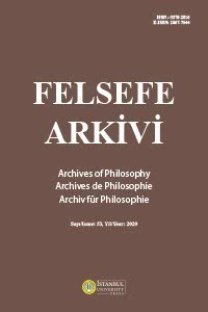Yapıyı Bükmek: Yapısalcılık ve Postyapısalcılık Ekseninde Jacques Lacan
Jacques Lacan, Derrida, Saussure, Yapısalcılık, Postyapısalcılık
Bending the Structure: Jacques Lacan Along the Axis of Structuralism and Poststructuralism
Jacques Lacan, Derrida, Saussure, Structuralism, Poststructuralism,
___
- Attridge, Derek. “The linguistic model and its applications”. In The Cambridge History of Literary Criticism. Volume 8. From Formalism to Poststructuralism, edited by Raman Selden, 58-84. Cambridge: Cambridge UP, 2008. google scholar
- Birlik, Nurten. “Lacan’s Complicated Relationship with Structuralism”. Ankara University, The Journal of The Faculty of Languages and History-Geography 59, 1 (2019): 529-542. google scholar
- Derrida, Jacques. Writing and Difference. Trans. A. Bass. London: Routledge, 2002. google scholar
- Eagleton, Terry. Literary Theory: An Introduction. Minnesota: The University of Minnesota Press, 2003. google scholar
- Evans, Dylan. An Introductionary Dictionary of Lacanian Psychoanalysis. London: Routledge, 2006. google scholar
- Fink, Bruce. The Lacanian Subject: Between Language and Jouissance. Princeton: Princeton UP, 1996. google scholar
- Lacan, Jacques. Desire and Its Interpretation. The Seminar of Jacques Lacan. Book VI. Ed. Jacques Alain Miller. Trans. Bruce Fink. NY: Polity, 2019. google scholar
- ———. Ecrits. Trans. Alan Sheridan. London: Routledge, 2015. google scholar
- ———. Formations of the Unconscious. The Seminar of Jacques Lacan. Book V. Ed. Jacques Alain Miller. Trans. Russell Grigg. Polity, 2017. google scholar
- ———. On Feminine Sexuality: The Limits of Love and Knowledge. The Seminar of Jacques Lacan. Book XX. Ed. Jacques Alain Miller. Trans. Bruce Fink. Norton & Company, 1999. google scholar
- ———. The Ego in Freud’s Theory and in the Technique of Psychoanalysis. Book II, 1954-1955. Ed. John Forrester. Trans. Sylvana Tomaselli. WW Norton & Company, 1988. google scholar
- --. The Seminar of Jacques Lacan. Book III: The Psychoses 1955—1956. Ed. Jacques Alain Miller. Trans. google scholar
- Russell Grigg. New York: WW Norton & Company, 1993. google scholar
- Newton, Kenneth McMillan. Twentieth-Century Literary Theory. Macmillan, 1997. google scholar
- Ryan, Michael. “Marxism and poststructuralism”. In The Cambridge History of Literary Criticism: 99108. Eds. Christa Knellwolf and Christopher Norris. Cambridge University Press, 2001. https://doi. org/10.1017/CHOL9780521300148.009. google scholar
- Sarup, Madan. Jacques Lacan. London: Harvester Wheatsheaf, 1992. google scholar
- Saussure, Ferdinand De. Course in General Linguistics. Eds. C. Bally and A. Sechehaye. Trans. W. Baskin. Philosophical Library, 1959. google scholar
- Schneiderman, Stuart. Returning to Freud: Clinical Psychoanalysis in the School of Lacan. Ed. & Trans. S. Schneiderman. Yale University Press, 1980. google scholar
- Selden, Raman et al. A Reader’s Guide to Contemporary Literary Theory. London: Pearson Longman, 2005. google scholar
- Spivak, Gayatri Chakravorty. “Translator’s Preface.” In Of Grammatology: ix- lxxxvii. Baltimore: The John Hopkins UP, 1998. google scholar
- Turkle, Sherry. Psychoanalytic Politics: Jacques Lacan and Freud’s French Revolution. NY: The Guilford Press, google scholar
- ISSN: 0378-2816
- Yayın Aralığı: 2
- Başlangıç: 1945
- Yayıncı: İstanbul Üniversitesi
Davidson'ın Metafor Kuramı Üzerine
Yapıyı Bükmek: Yapısalcılık ve Postyapısalcılık Ekseninde Jacques Lacan
Türkçe Literatürde Carl Schmitt Bibliyografyası
Platon’un Ruh (Psykhē) Anlayışı
Demet Teorisi, Işınlanma Paradoksu ve Zaman Felsefesinde Dört-Boyutçuluk Açısından Bir Yaklaşım
Akran Anlaşmazlığında Uzlaşımcılık ve Yüksek Düzeyde Gerekçeli İnançlar Problemi
Leibniz’in Erken Dönem Çalışmalarında Hareket ve Süreklilik
“Evet, Sokrates!”in Gölgesinde: Elenkhos Üzerine Bir Soruşturma
